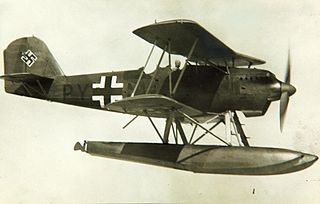
The Arado Ar 68 was a German single-seat biplane fighter developed in the mid-1930s. It was among the first fighters produced when Germany abandoned the restrictions of the Treaty of Versailles and began rearming.

The Heinkel He 60 was a German single-engined biplane reconnaissance seaplane designed to be catapulted from Kriegsmarine warships of the 1930s.

The Heinkel He 72 Kadett ("Cadet") was a German single-engine biplane trainer of the 1930s.
The Heinkel He 119 was an experimental single-propeller monoplane with two coupled engines, developed in Germany. A private venture by Heinkel to test radical ideas by the Günter brothers, the He 119 was originally intended to act as an unarmed reconnaissance bomber capable of eluding all fighters due to its high performance.

The Heinkel HD 42 50, later designated the Heinkel He 42 was a German two-seat biplane seaplane originally designed for the Deutsche Verkehrsfliegerschule, and later built for the German Luftwaffe. The aircraft was used until the end of World War II as a trainer for maritime pilots.

The Junkers Ju 46 was a German shipborne catapult-launched seaplane derivative of the W 34, constructed for pre-war Luft Hansa's mail service over the Atlantic Ocean. The first production models were delivered in 1932 and replaced the Heinkel He 58, which, along with the He 12, had pioneered these ship-to-shore mail delivery flights.

The Rohrbach Ro X Romar was a German long-range commercial flying-boat and the last aircraft designed and built by Rohrbach Metall Flugzeugbau GmbH.

The Heinkel HE 5, produced in Sweden as the Svenska S 5 and nicknamed the "Hansa", was a reconnaissance floatplane built during the 1920s. It was a further development of the HE 1, sharing its same basic configuration as a low-wing, strut-braced monoplane. The HE designation also refers to the monoplane construction, standing for Heinkel Eindecker.

The Heinkel HD 39 was a special-purpose cargo aircraft developed in Germany in the 1920s to distribute the Berlin newspaper B.Z.. It was a conventional single-bay biplane with staggered wings of equal span, and a fuselage that nearly filled the interplane gap. The pilot sat in an open cockpit, and the undercarriage was of fixed, tailskid type with divided main units. The sole example of the type was built after Ernst Heinkel found out, by chance, that B.Z. required such an aircraft and had ordered two machines from Albatros. Heinkel convinced publisher Ullstein-Verlag to purchase a third aircraft from his firm.

The Polikarpov TB-2 was a Soviet heavy bomber prototype designed and tested in the 1920s. It was a sesquiplane of wooden construction, with engines mounted on the bottom wing. Work on the sole prototype began in 1927 and it was tested in 1930. Although TB-2 performance was superior to that of the Tupolev TB-1 in service at the time, it was deemed insufficient for 1930 and the project was abandoned.

The Blohm & Voss Ha 140 was a German multi-purpose seaplane first flown in 1937. It was intended for use as a torpedo bomber or long-range reconnaissance aircraft, but did not enter production.
The Heinkel Doppeldecker 43 was a prototype German fighter aircraft of the 1930s. A single-engined, single-seat biplane, the HD 43 was designed to meet a secret German Reichswehr requirement for a single-seat fighter. It had two-bay wooden wings with a steel-tube fuselage, and was powered by a 750 hp (600 kW) BMW VI engine. The single prototype flew in 1931.

The Focke-Wulf Fw 62 was a reconnaissance floatplane, designed and built by Focke-Wulf for use by Nazi Germany's Kriegsmarine. Only four were built.
The Heinkel HD 19 W was a biplane seaplane fighter developed by Ernst Heinkel Flugzeugwerke.
The Heinkel HE 10 was a trainer floatplane developed by the German aeronautical company Heinkel Flugzeugwerke in the late 1920s.
The Heinkel HD 30 was a biplane reconnaissance seaplane developed by Ernst Heinkel Flugzeugwerke.
The Heinkel HD 34 was a reconnaissance bomber built in Germany in the late 1920s.
The Heinkel HD 41 was a reconnaissance developed in Germany in the 1920s.
The Kawanishi E13K, company designation AM-19, was a Japanese 1930s three-seat reconnaissance floatplane.
The Kawanishi K6K was a prototype Japanese training aircraft built by the Kawanishi Aircraft Company in the late 1930s.












